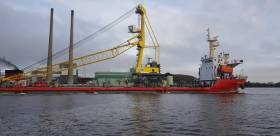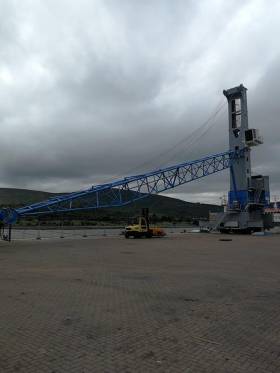Displaying items by tag: New Crane
Enough Talk Brings Second New Crane to Irish Shores - this Time Dublin Port
The second of two new cranes transported by sea to Irish ports, has been identified by Afloat to begin a career with a shipping agency located in Dublin Port, writes Jehan Ashmore.
The new cranes built by Liebherr in Germany where in recent weeks loaded onboard heavy-lift vessel, Enough Talk when berthed in Rostock. The port city located on the Baltic Sea is also where the cranes were manufactured.
As previously reported on Afloat, the first crane was delivered earlier this month to South East Port Services in the Port of Waterford. A close-up examination by Afloat (of the photo above) shows Enough Talk depart the south-east port with the second crane remaining on board and where clues were revealed to its destination.
Emblazoned on the crane is the initials DSG, standing for Doyle Shipping Group, a shipping agency and logistics company, originally founded in 1886 by Dennis Doyle in Cork. DSG provide a range of marine services including stevedoring with offices and warehouses in Irish ports and the operation of two private port facilities at Greenore Port in Co Louth and Cork Dockyard in Rushbrooke near Cobh.
The delivery voyage by Enough Talk to Dublin Port involved the Liebherr LHM 420 crane which according to DSG's Dublin office is an investment by the company of €4 million. The new port infrastructure is currently undergoing various attachment calibration and crane-driver inductions.
DSG operations in Dublin Port is based in Alexandra Basin (East) where the new crane joins an existing suite of also yellow-painted crane infrastructure sited along Alexandra Quay. At this terminal, break-bulk cargoes and lo-lo traffic is handled while ro-ro operations also take place at the adjacent Ocean Pier.
New £3m Crane At Warrenpoint Port Scheduled to Begin Operations in September
#Ports&Shipping- Work on the construction of a new £3m crane at Warrenpoint Port began last month following the investment as part of a bid to facilitate further growth ahead of Brexit and beyond at Northern Ireland’s second largest port.
The crane, which is supplied by Finnish manufacturer Konecranes, will significantly improve efficiency by reducing loading and unloading times with the ability to lift 100 tonnes up to 42 metres above sea level.
Clare Guinness, CEO, Warrenpoint Port commented: “It is an exciting time for Warrenpoint Port as construction of our latest crane addition begins, enabling us to further improve our already high standards of service to customers.
“The purchase of the Model 3 Mobile Harbour Crane, which itself will weigh 300 tonnes, is an example of our commitment to invest in our operations, thereby boosting prosperity in the area for both local people and businesses.”
Earlier this year, Warrenpoint Port announced a major 25-year growth plan which anticipates core roll on, roll off, freight to rise by up to 80% by 2040, regardless of the outcomes of Brexit negotiations.
Clare continued: “We are fully prepared for the forecasted growth in freight shipping, with two other cranes also undergoing refurbishment.”
The crane will take three weeks to assemble and a further two to commission before entering service in September.
When complete, it will help the Port, which deals with a variety of goods including steel and timber and offers a full range of shipping services further build on increasing levels of business. In 2017, the Port handed a record 3.56 million tonnes of cargo valued at £6.2 billion.
























